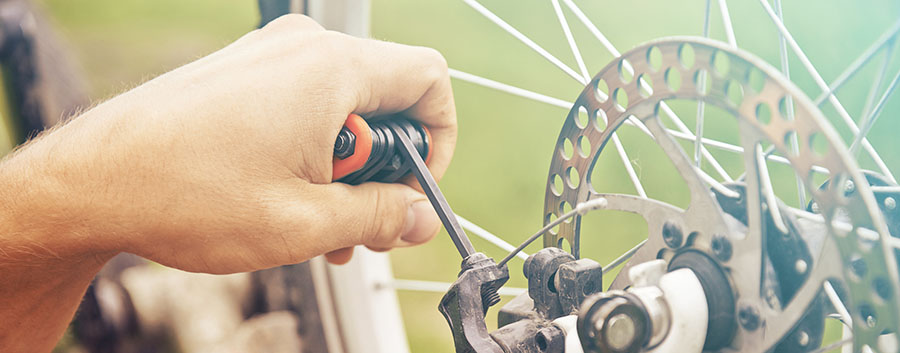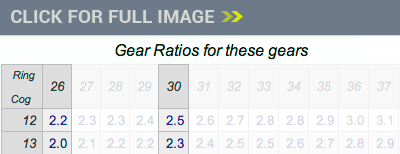The Gearing Dilemma
Like many individuals riding dirt, I’m considering going to a single chainring from the current double. What we’re going to do is look at the current maximum and minimum gearing ratios on my bike and see if it makes sense to go with a single chain ring. The same calculations can be performed if a person is going considering going from a standard road crankset to a compact, or deciding to upsize the rings on a time trial bike.
Here’s the thing, I’d prefer to not convert to an 11-speed rear since that requires a new cassette, derailleur, and freehub or wheel and turns out to be pretty pricey to effectively take stuff off the bike. Let’s see how that desire works out.

The Process
Before we run online to look at calculators, crunch numbers, and put credit cards on the glass at the local bike shop, we need to go for a ride. This is a time to be honest with yourself; go for an average ride. When you’re out on the bike, pay attention to what gears you’re using and the cadence or speed you’re riding at—mostly one ring, mostly the low end of the cassette? This becomes very important later. Then after you’ve done that ride—preferably multiple rides to establish a good average—go out for an outlier ride. Something with a ton of hills, or the flat TT course with a slight tail wind. Again pay attention to the gears you’re using and the cadence or speed you ride.
Since I’m going to be the guinea pig again, I’ll let you know the results of my survey. On single track, I find myself in the small ring, middle cassette; on steep hills (15-25 percent) I’m in the small ring, lowest cassette cogs; on fire roads I’m in the big ring, faster half of the cassette. In general, it seems my bike is geared faster than I normally ride—I spend more time in lower gears than higher gears. My baseline configuration is a 26-39T double crankset with a 12-36 cassette, giving the bike a maximum gearing ratio of 3.3 and a minimum gearing ratio of 0.7 and an average cadence of 70. Using this calculator, my example looks like this:
When you click on the thumbnail image, you'll see a pop-up chart of all possible gear ratios given a range of chainringsfrom 26-39 and cog sizes from 12-36, with my specific setup.
So what does that all mean? Let’s look at my low end gear ratio—0.7. What would it take to get something like that with a single chainring setup? Let’s look at a 30-tooth chainring for now; a 30-36 gear gives us a high 0.8. Looking at my current gearing, a high 0.8 is about 26-32. This means if I went to a 30 tooth single chain ring, I’d effectively lose my lowest gear—a gear I only find myself using while spinning above 10 percent and standing above 18 percent. Those instances are pretty rare, times when I might only be going 2-4 mph but I might find myself pushing uphill a little more often when super steep and I’m tired. Looking at this chart, it may seem a little daunting with all the numbers. For convenience, it shows every gear between the specified maximum and minimum. Meaning the only boxes we’re interested in are the furthest right and left columns—the chain ring size—and the rows: 12, 13, 15, 17, 19, 22, 25, 28, 32, and 36 for our cassette cogs.
So far a 30-tooth seems feasible; let’s look at the top end. In 30-12, my gearing ratio is 2.5; on a 39-tooth ring, that corresponds to somewhere between a 15 and 16-tooth cog on the current setup, meaning I’d lose about two gears on the top end. Usually I find myself using those gears when ferrying the bike on pavement or on downhill segments. These instances are even more infrequent than my low end gears, and arguably less important—how much time would be saved in a race getting the last mile per hour or two out of the top end?
Based on my example, given my current riding habits, I could really work using a 30-tooth chain ring or make life a little easier using a 28-tooth chain ring, effectively sacrificing three gears on the top end. This same process could be used to convince myself whether or not it would be wise to convert my road bike from a compact crankset (50-34T) to a standard crankset (53-39T).
Another fun feature of the gearing calculator I used above: on the left hand tab there is a link called “speed at cadence” where a user can input their gear sizes and a range of cadences to develop a matrix of speeds. My example, using the 30T ring, looks like the following (keep in mind optimal cycling cadence is generally 90 rpm):
Looking at the speeds, compared to what I’m used to seeing on my Garmin, things look good. I rarely drop under 2 mph and am usually too concentrated on not hitting something and crashing to see myself in the 20s. I’m certain that for some time after putting a 30T on, I’ll feel limited on the top and bottom end, but will get used to it. Based on the speeds listed and considering the gears I’d be forgoing, it seems like the 30T is the way to go.
After writing the previous sections, I went out on the mountain bike considering my gearing limitations. I went out, after a hard ride the day before, and rode a route at a pace which would usually have me pretty tired given no gearing restrictions—I considered this my worst case, tired. When I went out, I remembered my restrictions, no lowest gear and the top two were off limits. I was able to go out and burn down a fire road in the mid 20 miles per hour—indicating I was riding well above the 80 RPM from the example—and able to spin up an, admittedly short, 18 percent grade without significant difficulty.
It appears a 30T single chain ring will work for me. If I find myself needing more range, certainly changing the chain ring to a different size is an option; I could also change out my lowest cassette cog to one of the 42-tooth cogs that are made to go back to my original gear ratio of 0.7.
Summing It Up
The example which was given in this article, while specific to mountain biking, can be adapted to any type of cycling for an individual which is considering a gearing change. The methods and information provided in the example would be the same across mountain biking, road cycling, and time trialing—albeit with different numbers as the inputs. At the end of the day, the sole determining factor is the riding experience. While it’s not always practical to go through many changes in drive trains looking for the sweet spot, an individual may be able to determine a fairly close setup analytically as developed in these articles.
I'm ready. Lets upgrade my kit.
This article was written by Matt Shinavar


